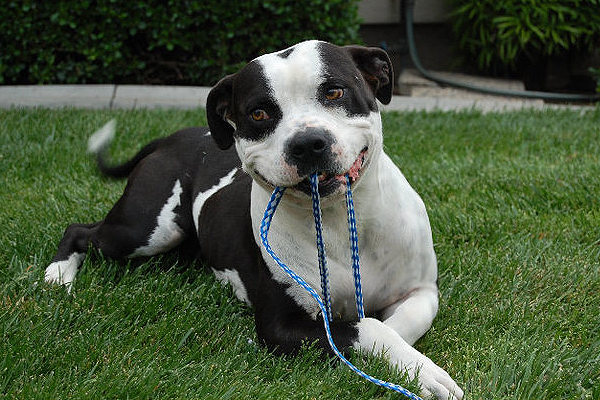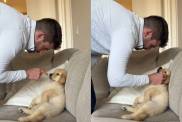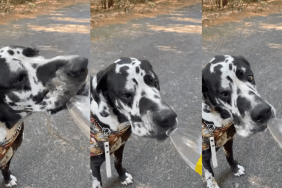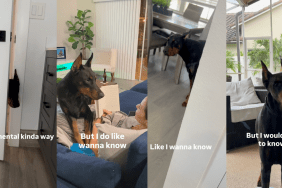By Pam Frazier, StubbyDog.org
A little more than year ago, if you had told me I would have a Pit Bull lying on my living room floor, I would have called you a liar. Here’s the story of how a Pit Bull began snoring on my couch:
Every week, we had to go into the area where Buddy lived to assist a relative. Buddy lived in a large yard with a chain link fence. He was usually lounging in the dirt or standing at the fence happily wagging his tail.
One Saturday, he looked like he was having some trouble walking. His hind legs didn’t move quite right. We wondered if maybe a car had hit him. The next Saturday, he didn’t get up off the ground to come to the fence. We asked his owners what was wrong with their dog. They said they didn’t know; he just quit walking. We told them he had to go to a veterinarian. They said they were going to take him to our local animal shelter and leave him there.
Our county animal shelter is a kill shelter where a Pit Bull type dog, especially one that could not walk, would die. I asked the owners to let me take the dog to our vet with the understanding that if they let me take him, he would become my dog and would not be returned to them. I really didn’t know if he could be saved or walk again. I knew our vet might say he had to be euthanized, but at least, I thought, this would be more humane than dying in the backyard or at a shelter. They let me take the dog.
We went straight to the vet. Buddy smelled so bad and had the biggest head I had ever seen on a dog. He laid there in the waiting room happily wagging his tail for everyone.
The vet examined Buddy and found that he had no reflex response in all four legs. After finding a bunch of ticks, tick paralysis was the first diagnosis. A secondary diagnosis was a neurological issue. The vet told us neurological issues in dogs sometimes resolve themselves and, if so, it would take about three weeks of care to improve as much as possible.
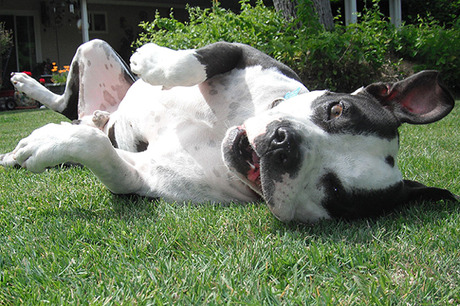
Wait and See …
We took him home. I carried him in the house and laid him in the bottom of our shower. He got shampooed twice.
We were surprised to discover that Buddy was housebroken. Even when he was crawling, he has never had an accident. We had quite a routine for bathroom breaks. First thing in the morning I would carry him (all 65 pounds) outside to the grass. He would crawl around a little, get his hind legs under him and lift himself up just a little. When he was finished with his business, he would quickly crawl away. I would pick him up and take him back to the living room where he would sleep, eat, take his meds … then I would carry him back outside. We repeated this four to five times a day.
Sometimes he acted like he wanted to crawl outside, but his chest and legs would get abrasions from crawling on concrete. It was hard on his body, so I kept carrying him. He started giving me big Buddy kisses whenever I picked him up. It made me laugh. I would get big Buddy facials several times a day.
A Sad Past
After a week, the tests came back negative for tick paralysis. Back in Buddy’s old neighborhood, we wanted to see if we could get any information about his health from his former owners.
I asked, “When was the last time he had his shots?”
“We found him next to the road when he was a puppy,” they said.
“When did he last see a vet?” I asked.
“We found him under a house, next to the road, when he was a puppy a couple of years ago,” they said.
At this point, I realized he had never seen a vet. So I asked what happened to him, could a car have hit him?
“He was fed gunpowder to make him mean. It didn’t make him mean it made him sick. He threw up. I thought he was constipated. I gave him some Ex-Lax,” they said.
“Why can’t he walk?” I asked.
“He might have been hit with a four-point tire iron,” they said. “Richard was mad at him. We found the tire iron in the yard, next to Buddy and he had trouble walking.”
Getting hit with tire iron would support the neurological issues the vet had talked about. Because all four legs were affected, the vet thought Buddy might have two spinal problems, one in his neck and one in his lower back. We went back home.
As the three weeks of neurological care were coming to an end, Buddy was still not walking. He was stronger and healthier, but he couldn’t walk.
We were at a crossroads. We knew that if he couldn’t walk, he’d have little quality of life. I looked into wheels for handicapped dogs, but there was nothing available for a dog unable to use any of his legs. I knew he was tired of crawling. Crawling, even in the grass, took so much out of him.
I remember sitting in a lawn chair in the yard with him during that third week. He crawled over to me with his big sad eyes and laid his head on my leg as if he was saying, “I’m tired. I can’t do this anymore.” I cried as I rubbed his head and told him I understood. I was tired, too. I was heart-broken.
Whatever it Takes
We decided we needed to do whatever we could to get Buddy up and walking. If the cost was more than we had, we would continue until we maxed out our credit cards.
We went to an internal vet specialist who wanted to run various tests but told us if they couldn’t figure it out, the best thing for Buddy would be to put him to sleep.
The specialist told us he thought Buddy had myasthenia gravis and they did a “quick-test” injection. If Buddy immediately got up and walked, myasthenia gravis was the diagnosis. Buddy did not walk after the injection. They took spinal fluid for further testing, and we took him home again to wait on the results.
The specialist put Buddy on prednisone. Three days later, Buddy took his first wobbly steps!
As the prednisone dosage increased, Buddy’s walking improved. Slowly at first, a few steps became a few yards, which became half a block. About a month later, Buddy could walk a mile. At the vet he had a normal reflex reaction in all four legs for the first time! He was on a high dose of prednisone for 60 days before being weaned off.
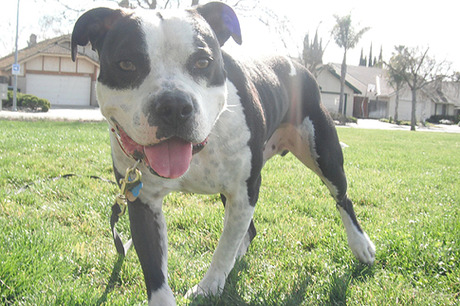
When was neutered, we did a blood DNA test and we joked that he was just a really, really large Boston Terrier! The results came back that he was 99 percent American Staffordshire Terrier and 1 percent Boxer.
After awhile, he started walking slowly again and having some issues ambulating. When the vet checked his reflexes, they didn’t react appropriately. So he went back on steroids for another month and since then, he has been healthy.
Second Chances
Now he runs and plays like any other dog would. His legs sometimes shake and tremble, and we attribute this to the neurological damage done to his spine. We know this may come and go, and he may have to take prednisone again in the future.
Buddy is a real trooper to have been through what he has and still be the loving, goofball, happy dog that he is!
The story behind his name is that it came in parts at different times. At home, I started calling him BudRose because of his stench that first day and because I liked the sound. That became Buddy Rose. Because of his black and white fur, he looked like he was wearing a tuxedo. When he got his first ID tag, I added “Mr.” for the noble, tuxedo-dressed boy he was … thus his new, final name, “Mr. Buddy Rose.”
Today, Mr. Buddy Rose gets the royal treatment for the noble dog he is. He spends his days sleeping on “his” couch and playing or wrestling with Mollie. Mollie wrestles with her whole body, while Mr. Rose wrestles with his big ol’ head! He loves to be outside, rolling or sleeping in the grass. His favorite thing is a long walk to the park. I can now walk him twice a day for a total of about five miles. He dances, prances, wiggles, pony-hops and yaps when he is happy. Every day, as we go out for our walks, he announces his walk to our entire neighborhood with his Big Buddy woofs! This summer he has learned to swim – always with a life jacket to ensure his big head stays out of the water!
Mr. Rose has completed basic obedience. And, although we are a long way from our goals, we work on them daily. I believe each abused or neglected dog comes with his/her own set of issues. Pit Bull type dogs get such a bad rap from the media. I would love for him to be a part of changing people’s minds about Pit Bull type dogs. He has already done some of that with my neighbors and people at the park. I believe he is and could be an “ambassadog” for Pit Bull type dogs. One day, I hope he will be a Canine Good Citizen, and then we’ll work on him being a therapy dog. He is so good with children. Someday I would love for him to be able to work with them in some capacity.
You can read Buddy’s blog by clicking here.
